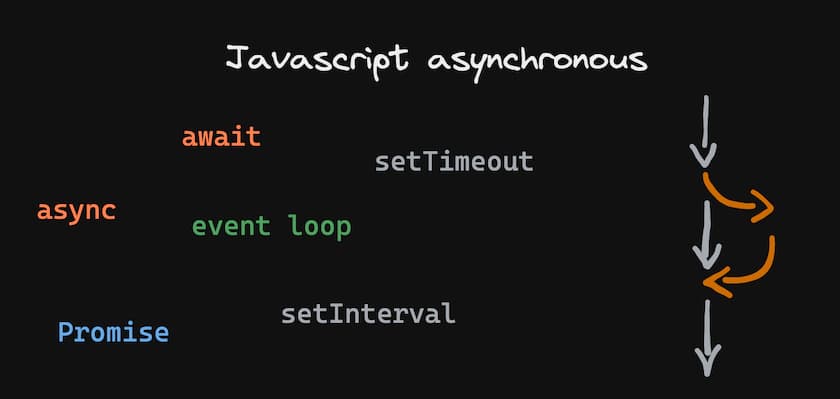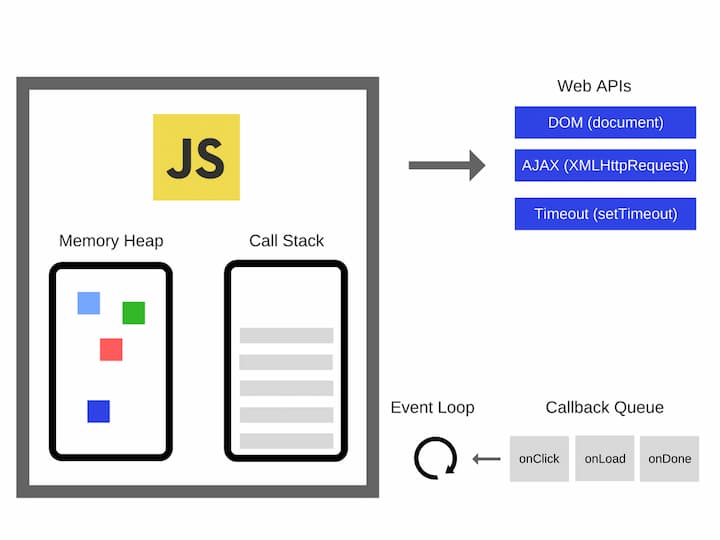Asynchronous JavaScript
February 23, 2022 — 4 min read

The Basics
If you have been using JavaScript for a while you probably have already used asynchronous concepts
concepts, from the famous setTimeout/setInterval, Promise, async/await
and the like.
First I would like to point out how JavaScript works under the to make it easier to understand what this asynchronicity is all about.
Event Loop and Event Queue
For those who know a little more than the basics of JavaScript will have heard of the famous Event Loop architecture.
The Event Loop is nothing more than a cyclical way of executing the actions we send to JavaScript, so the process is only finished when there are no more events to be events to be executed or for other reasons, such as an error that breaks this queue. An example of code for the Event Loop would look something like this:
while (queue.waitForMessage()) {
queue.processNextMessage();
}
The Event Queue is nothing more than the queue that manages the order in which these messages by the Event Loop, that is, if it is a queue, the first event that is executed is the first to arrive in the queue, so as we are dealing with a queue and one message follows the other we call it synchronous code, since a message will only be one message will only be processed after the other.

Asynchronous events
Well, from what I commented before, the events all happen synchronously, so how were asynchronous events handled?
how were asynchronous events handled before we had high-level API’s like Promise and
level APIs like Promise and async/await? There are several ways, and one of them is very
common to use in the browser, which is the standard Observer, where a listener is
listens for changes to a particular event. One example is the old API for
to make requests, the late XMLHttpRequest:
const xmlHttp = new XMLHttpRequest();
xmlHttp.responseType = 'json';
const url = 'https://api.github.com/users/azagatti';
xmlHttp.onreadystatechange = () => {
// other implementations
console.log(xmlHttp.response);
};
xmlHttp.open('GET', url);
xmlHttp.send(null);
In this case we registered a function in the onreadystatechange property of the
with the XMLHttpRequest instance and then, when using send we get
return this data in the response, so all the logic for when the data is
received should be inside this function assigned to onreadystatechange.
Another classic example of asynchronous programming is setTimeout
(and setInterval), where the assigned function is executed after the given time,
but a classic exercise about this function, what is the order of execution of these
logs? 🤔
setTimeout(() => {
console.log('1');
}, 0);
console.log('2');
The order of the logs is: 2 -> 1. This is because the setTimeout enters the asynchronous event queue.
events, even though the time entered is 0, the Event Queue will prioritize the
only then will the setTimeout function be executed.
Promise
Promise” is a broader concept than the name implies, it is a promise to wait.
that must be expected. Since there are many ways to work with asynchronous,
one of the best known by JavaScript users is to work with callback.
There are many ways to use callbacks as well, but the most followed pattern in
in JavaScript is to send a success and a failure function to an asynchronous
method.
function successCallback(result) {
console.log('It succeeded with ' + result);
}
function failureCallback(error) {
console.log('It failed with ' + error);
}
doSomething(successCallback, failureCallback);
Looking at it this way may seem simple, but when there are chained events that
we get a famous problem, known as callback hell.
callback hell
a((resultFromA) => {
b(resultFromA, (resultFromB) => {
c(resultFromB, (resultFromC) => {
d(resultFromC, (resultFromD) => {
e(resultFromD, (resultFromE) => {
f(resultFromE, (resultFromF) => {
console.log(resultFromF)
});
});
});
});
});
});
With the arrival of Promise, we’re able to work more elegantly, there’s still
there is still chaining, but we have advantages, such as the callback passed
will only be executed at the end of the current Event Loop execution cycle,
while the Promise does not depend on it. To get the result of a Promise we must use the keyword then`.
a().then((resultFromA) => {
return b(resultFromA)
})
.then((resultFromB) => {
return c(resultFromB)
})
.then((resultFromC) => {
return d(resultFromC)
})
.then((resultFromD) => {
return e(resultFromD)
})
.then((resultFromE) => {
return f(resultFromE)
})
.then((resultFromF) => {
console.log(resultFromF)
})
Obviously these examples have a lot of strings, which is not very common,
but when you have a case where you need too many strings, even Promise won’t work.
won’t even solve it, but at least it becomes more readable and safer to use.
The Promise object
Above I showed you how a Promise is used, but to create one there are a few
one of them is using the global Promise object, inside this object
object, there are many useful methods for working with Promises, but I will focus on the
but I will focus on the basics.
A Promise can be created with the keyword new where we pass a function that has
two functions in its parameters, resolve and reject. The resolve function returns
the data passed if the Promise is completed, while reject returns an error from this
Promise.
new Promise((resolve, reject) => {
resolve(console.log('Initial'));
})
.then(() => {
reject('Something failed');
console.log('Do this');
})
.catch(() => {
console.log('Do that');
})
.then(() => {
console.log('Do this whatever happened before');
});
In the log it will appear: Initial -> Do that -> Do this whatever happened before.
Evolving with async and await
There are many cases where using then to wait for a Promise starts to get
complex, creating several closures at different levels, so
implemented a feature in JavaScript where we can create a Promise from a common
from a regular function, rather than using the global object.
With the keywords async and await we can work imperatively
asynchronous programming as if it were synchronous.
async function getGithubData() {
return fetch('https://api.github.com/users/azagatti')
}
async function myPromise() {
const response = await getGithubData()
const data = await response.json()
return data
}
console.log(await myPromise())
Normally it would not be possible to use await in a scope outside of a function
function with async, but recently a new feature came into v8 (main JavaScript engine)
JavaScript engine), called Top-level await,
so we can use await outside of async functions in newer
versions of browsers and servers that run v8.
Getting back to the point, as in the example shown, we can wait for asynchronous operations
and then run other synchronous processes, it generally helps to maintain
readability of the code and keep the code clean by creating new variables and
functions. Remember that whenever we add the prefix async to a
function, it automatically becomes a Promise, so when we use
we must use then or await, otherwise it will run and we won’t get any
feedback, and there are cases where we really don’t need it.
Finishing
Finally, always use return if you are using then inside a
function with async, otherwise the compiler will just ignore it and run in background,
what I recommend is to choose one of the approaches to the case, either use async
together with await or then. I should also bring up another article about the methods
we can use with Promise since they are many and have many uses.
